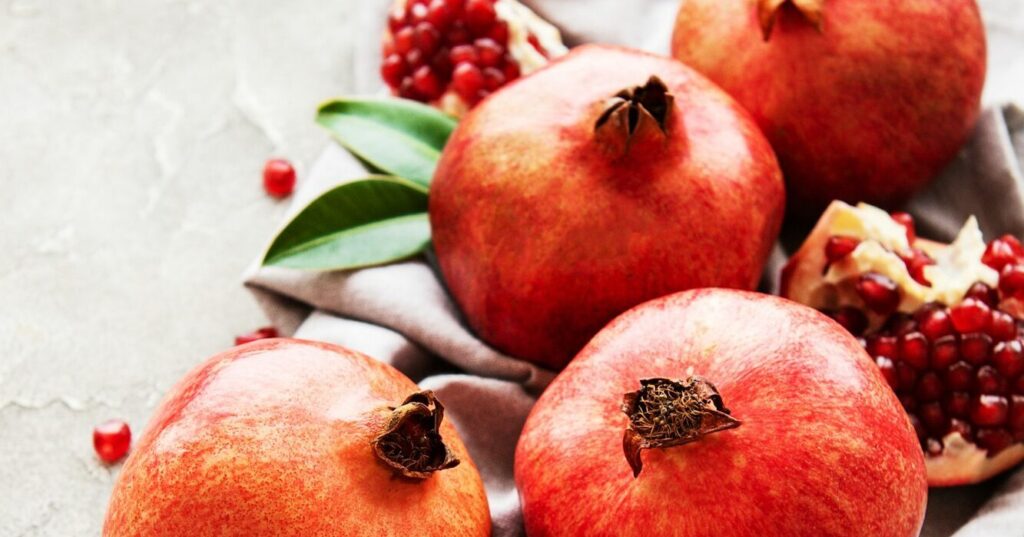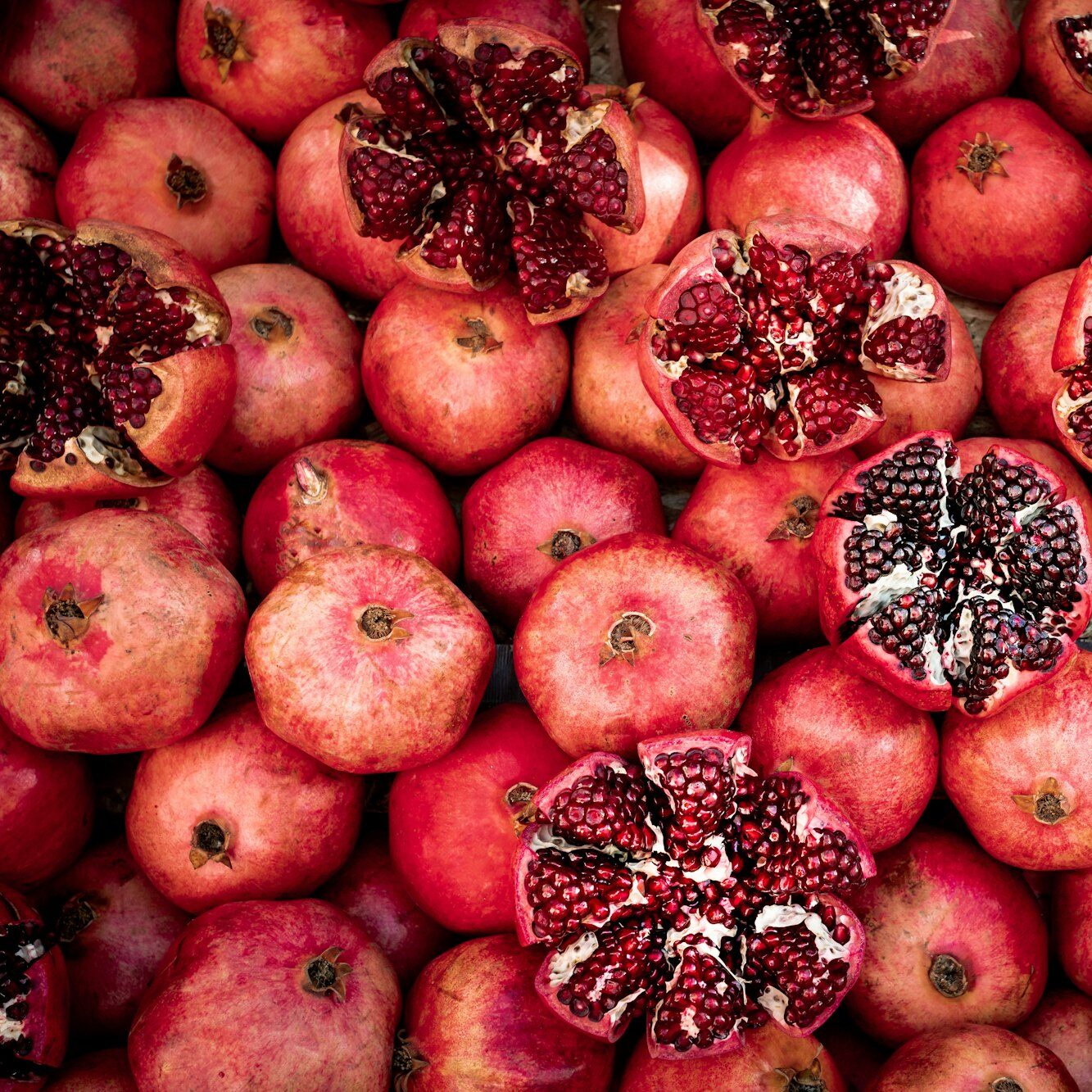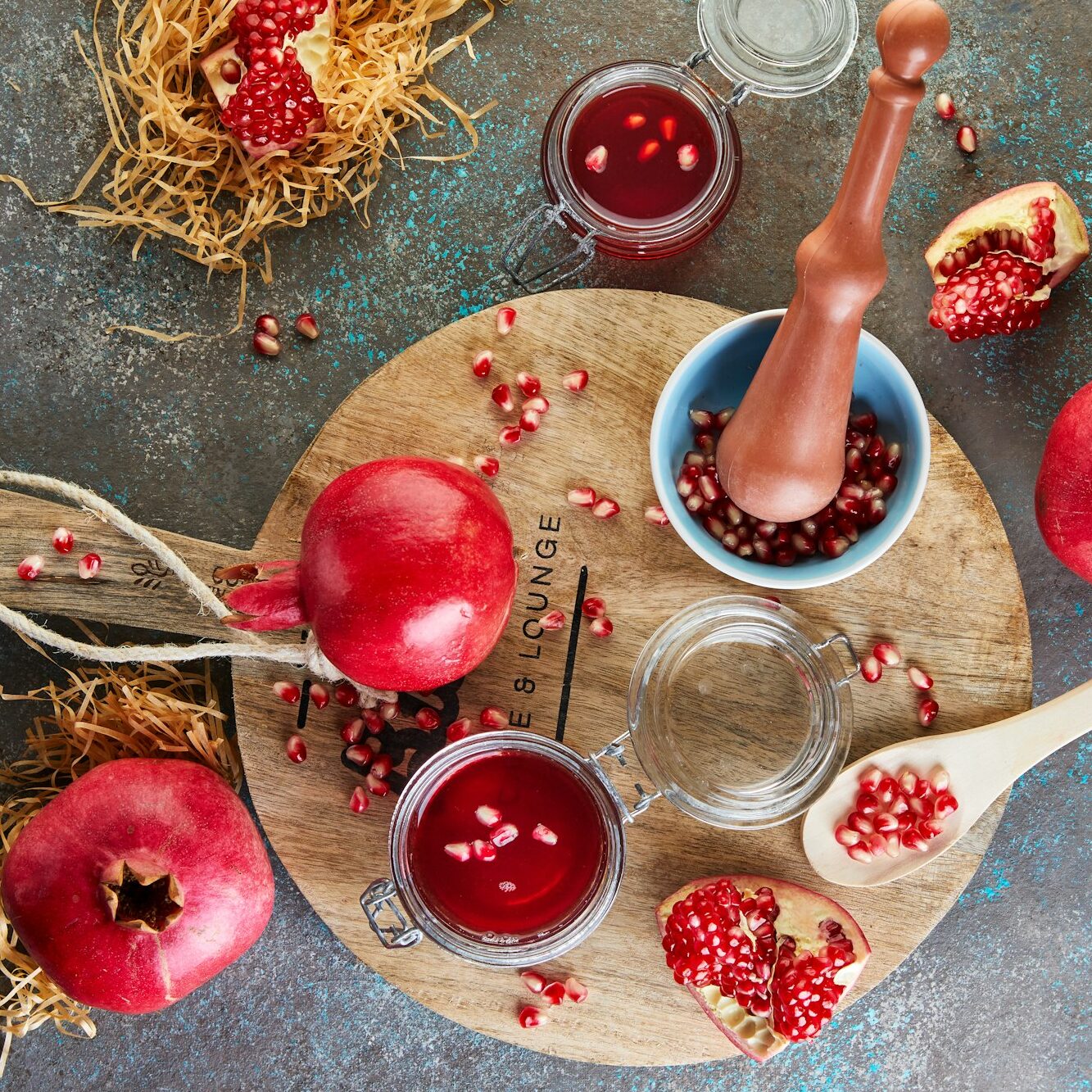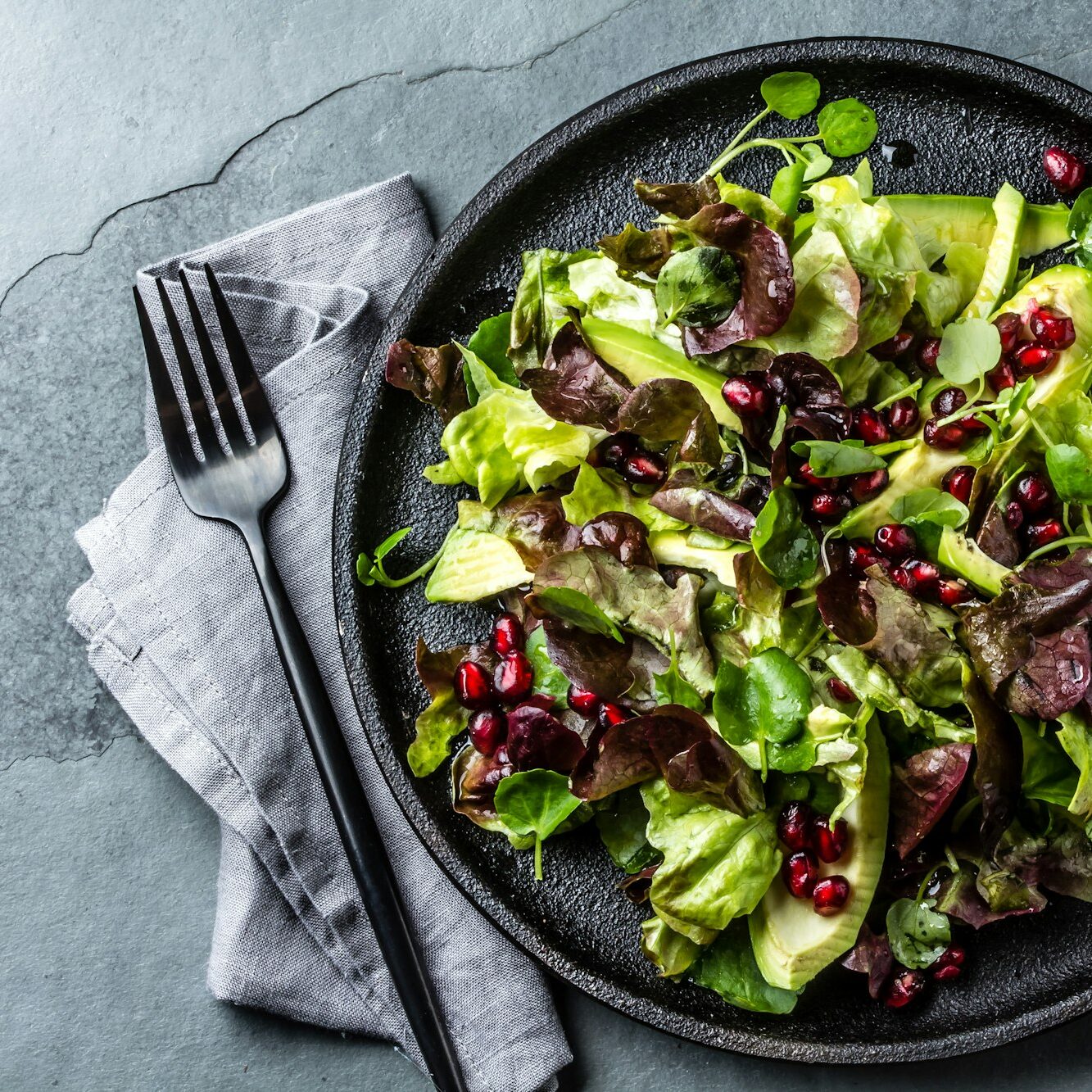Autumn’s Crown Jewel Returns

Delving Into the Unique Health Benefits of Pomegranate
Each autumn we are graced with the return of the pomegranate, the most royal of the fruits.
The small ruby red seeds, or arils, are packed with antioxidants that fight anything from cancer to helping lower blood pressure. This exotic fruit, that sports its own distinguished crown, historically symbolizes abundance, prosperity and even good luck. Grab some of these exotic fresh fruits at the farmers’ market where they are proudly displayed until January or pick some up at your local grocery store.
History
Pomegranates, which originated in Persia (modern day Iran), the Mediterranean and North India, have been cultivated since ancient times. It’s believed that in the late 16th century they were introduced in the Spanish Americas and then brought to California by Spanish settlers in 1769. Some say pomegranates got their name from the ancient Romans and were originally referred to as malum granatum, but others propose that the name came from the French word pomme garnete, which means “seeded apple.”
In America, pomegranate was originally associated with the grenadine syrup found in our Shirley Temples or cocktails, but from the Himalayas to Asia, Africa and Europe, it has been a primary ingredient in many dishes. Pomegranate has and is used as a dry spice in traditional dishes and as an acidic agent for curry and chutney preparations.


Health Benefits
The pomegranate has been recognized as “nature’s power fruit.” Dating back to Biblical times, the tree itself was known to possess remarkable medicinal properties. Packed with antioxidants like flavonoids, tannins and anthocyanins, it’s numbers are off the charts — anti-oxidant capacity tests indicate that its antioxidant activity is three times higher than red wine and green tea. Not only that, it also it contains noteworthy amounts of Vitamin C and potassium.
The pomegranate’s medicinal contributions may also be correlated with its significant anti-inflammatory effects, which suggest a wide range of clinical applications for the treatment and prevention of cancer and other diseases associated with chronic inflammation.
The anatomical compartments of the pomegranate tree and fruit have interesting pharmacologic capabilities. Juice and peels, for example, possess potent antioxidant properties, while juice, peel and oil all have mild effects on estrogen levels and therefore can aid in the treatment of menopausal symptoms. Pomegranate juice, peel and oil have also been shown to possess anti-cancer activities according to studies.
Potent Anti-Cancer Activity: Prostate, Breast, Lung & Colon Cancer
The unique biochemical, rich in antioxidant, composition of the pomegranate fruit has exceptional healing qualities. Research has shown that pomegranate extracts selectively inhibit the growth of breast, prostate, colon and lung cancer cells in culture. In animal studies, oral consumption of pomegranate extract inhibited growth of lung, skin, colon and prostate tumors. Additionally, an initial Phase II clinical trial of pomegranate juice in patients with prostate cancer reported significant anti-cancer activity. Similar studies have indicated potential to prevent formation of breast cancer cells.
Significant Cardiovascular Benefits
The pomegranate and its juice have shown beneficial medical activity in cardiovascular function. Specifically:
Pomegranate juice prevents the build up of plaque on the arterial walls and may actually help reduce previous buildup. According to Dr. Edward Group of The Global Living Center, the anti-oxidants in pomegranates act much like aspirin in their ability to deter the blood platelets from sticking together and forming blood clots.
Not only do pomegranates have the ability to lower the levels of LDL cholesterol (bad cholesterol) but they can also raise the levels of HDL (good cholesterol) thus having a dual therapeutic benefit.
According to Health Diaries, studies have shown that drinking 1.7oz of pomegranate juice per day can help to lower systolic blood pressure up to approximately five percent.
Skin Rejuvenation Advantages
Pomegranate seed oil has been shown to stimulate a mild thickening of the epidermis, the outer most layers of skin. The peel extract (and to a lesser extent, both the fermented juice and seed cake extracts) have shown to stimulate pro-collagen synthesis, which facilitates skin repair by promoting regeneration of dermis3.
Type 2 Diabetes Activity
Over the last decade, various studies have linked pomegranate with type 2 diabetes prevention and treatment. Early research studies provide evidence for the anti-diabetic activity of pomegranate fruit in Type 2 diabetes, which is thought to occur by reducing oxidative stress and lipid peroxidation.


De-seeding a Pomegranate
Please note that pomegranates may stain your hands, clothes and even countertops, so take care when deseeding a pomegranate. Here are some tips for an easy way to de-seed a pomegranate:
Score the pomegranate horizontally around the middle. Just cut the leathery skin but try not to cut into the fruit.
Now score four vertical lines around the pomegranate.
Tear or cut the pomegranate in half and then along the horizontal lines, break it into quarters.
Turn the pomegranate seed-side down and gently tap the back of the pomegranate with a wooden spoon over a large bowl.
Another method would be to submerge your pieces into a bowl of water. While this may prevent the juices from spraying and minimize the potential for stains, you lose the juice that would otherwise be retained in the method above
Selecting Pomegranates
The first rule of thumb when choosing a pomegranate is to go for the heavy ones. The heavier they feel, the juicier they tend to be. The best ones will have a glossy, smooth and unbroken surface. Look for pomegranates with a deep colored rind that doesn’t have any soft spots. When the skin starts to break open they are in the peak of their ripeness. Interestingly enough, an unripe pomegranate is round like an apple but when the shape changes and becomes squarer, that indicates that the fruit is ripe. You may also do a scratch test: if you can scratch the pomegranate with your nail and leave a mark, it is most likely ripe.
Storing Pomegranates
Pomegranates may be stored at room temperate for a week, in the refrigerator for a month or in the freezer for up to a year. If you deseed your pomegranate you may put the seeds in an airtight container or plastic bag and leave in the fridge for about five days. If you choose to freeze your pomegranate seeds the best method is to freeze the seeds in a single layer on a cookie sheet in the freezer for a couple of hours before placing them in an airtight container. This method will prevent the seeds from sticking together which makes future use much easier.
Fun Facts
- Ancient Egyptians buried their dead with pomegranates, which were thought to bring about eternal life.
- Greeks to this day, break open pomegranates at weddings and on New Year’s Eve.
- The Chinese eat candied pomegranates as a symbol of good luck.
Some scholars believe that Eve may have indulged on a pomegranate in the Garden of Eden as opposed to an apple. - And last but not the least; start counting… It is argued that there are exactly 613 seeds in every pomegranate.


